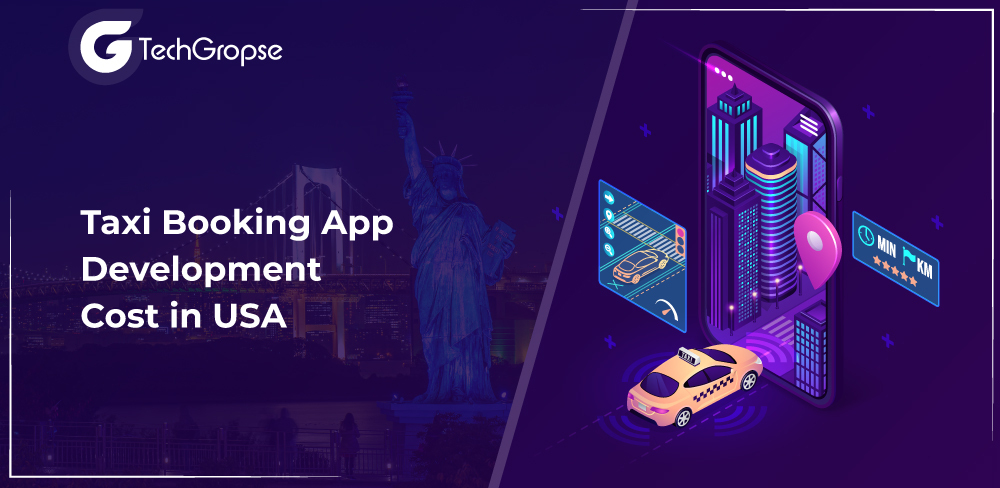Are you an entrepreneur in the taxi industry, looking to elevate your business presence and streamline your services? But you are stressed about the taxi booking app development cost in USA. Well, the solution lies in embracing the power of an online taxi booking app.
Gone are the days of depending exclusively on traditional taxi services. The landscape has shifted with the meteoric rise of industry giants like Uber, Ola, and Lyft, setting the precedent for taxi-booking applications to dominate the market.
For a simple taxi booking application enclosing basic features, you can expect the mobile app development cost to range from $20,000 to $50,000.
According to the research, the number of users in the ride-hailing and taxi sector is expected to reach 1,665.3 million by 2026. Investing in taxi applications now presents a strategic opportunity for exponential business growth and market expansion.
Now, let’s move forward and learn about taxi booking app development cost in USA in detail. Read on!
How Much Does it Cost to Build a Taxi App?
Now it’s time to answer the important question – What is taxi booking app development cost?
However, it’s crucial to note that this figure varies based on factors such as app complexity, desired features, developer location, and other project-specific requirements.
| Development Phase | Cost Range (USD) |
| Planning and Analysis | $3,000 – $5,000 |
| Design | $5,000 – $10,000 |
| Frontend Development | $10,000 – $20,000 |
| Backend Development | $15,000 – $30,000 |
| Testing and QA | $5,000 – $10,000 |
| Deployment and Launch | $3,000 – $5,000 |
These cost estimates are approximate and can vary based on factors such as the complexity of features, platform selection (iOS, Android, or both), developer rates, geographic location, and project-specific requirements. It’s essential to consult with a mobile app development company to get a more accurate estimate tailored to your specific needs and objectives.
Maintenance and Support of Taxi Booking App Development Cost in USA
Post-launch, ongoing maintenance, and support are imperative for addressing user feedback, implementing updates, and resolving issues promptly. Hire dedicated developers who ensure the long-term sustainability and success of the taxi booking app.
| Maintenance and Support Services | Cost Range (USD/month) |
| Bug fixes and minor updates | $500 – $1,000 |
| Regular software updates and feature enhancements | $1,000 – $3,000 |
| Server maintenance and monitoring | $500 – $1,500 |
| Technical support | $500 – $1,500 |
| Security updates and compliance maintenance | $500 – $1,000 |
These cost estimates are approximate and can vary based on factors such as the complexity of the app, the frequency of updates, the level of technical support required, and any additional services included in the maintenance package. It’s essential to discuss your specific maintenance and support needs with a reliable on demand app development company partner to get a tailored estimate for your taxi app.
Must Read: Unveiling the Hidden Cost to Develop a Taxi Booking App
Final Thought
The cost of taxi booking app development is influenced by a multitude of factors, including feature set, platform selection, design, backend infrastructure, security, testing, and ongoing maintenance.
By partnering with a reputable taxi booking app development company and carefully considering each aspect, you can navigate the development process efficiently and unlock the full potential of your taxi business in the digital age.
FAQ
1. What factors influence the cost of taxi booking app development?
Various factors can affect the cost, including the complexity of features, platform selection (iOS, Android, or cross-platform), design requirements, backend infrastructure needs, security measures, and ongoing maintenance and support.
2. What are some essential features that contribute to the development cost?
Key features such as user registration, real-time GPS tracking, fare calculation, payment integration, driver dispatch, and user feedback mechanisms are fundamental to a taxi booking app.
3. How can I optimize costs during taxi app development?
To optimize costs, consider prioritizing essential features for the initial release and incorporating additional features in subsequent updates. Choosing a cross-platform development approach, leveraging existing third-party APIs for certain functionalities, and outsourcing development to regions with lower labor costs can also help manage expenses.

Hello All,
Aman Mishra has years of experience in the IT industry. His passion for helping people in all aspects of mobile app development. Therefore, He write several blogs that help the readers to get the appropriate information about mobile app development trends, technology, and many other aspects.In addition to providing mobile app development services in USA, he also provides maintenance & support services for businesses of all sizes. He tried to solve all their readers’ queries and ensure that the given information would be helpful for them.










